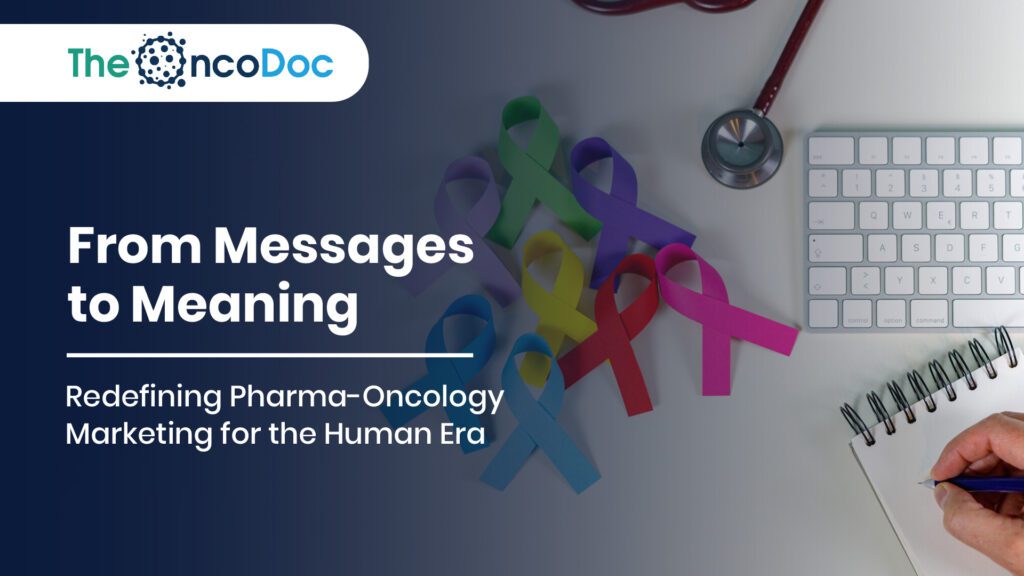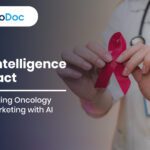Introduction: Where Innovation Meets Intention
Oncology today is driven by more than treatment protocols, it’s shaped by genomic insights, AI-powered diagnostics, patient empowerment, and clinical decisions made in moments that count. However, pharma marketing still struggles to keep pace with this rapid evolution.
Modern oncologists are analytical, digitally engaged, and pressed for time. They demand precision, not promotional noise. At the same time, patients are becoming proactive participants, seeking clear, compassionate communication over medical jargon. The traditional top-down model of pharma messaging no longer resonates.
To stay relevant, oncology marketing must evolve from pushing content to enabling clarity, from selling to supporting. It must harness the power of AI, leverage real-world data, and embed itself into everyday clinical practice through empathy and action.
This article redefines oncology pharma marketing as a convergence of science, technology, and humanity. It explores how brands can become trusted partners in care by designing for decision support, co-creating with healthcare professionals, and aligning every message with moments that truly matter.
From hyper-targeted engagement to smarter field force models and culturally grounded patient tools, we present a roadmap to marketing that is not just informative, but indispensable.
Section 1: Beyond Messaging – Building Clinical Utility
In oncology, awareness is not enough. Clinicians need content that sharpens judgment, accelerates decisions, and adapts to the evolving complexity of care. Yet, much of pharma marketing still focuses on brand recall rather than clinical action. To be truly impactful, brand engagement must be rooted in utility, designed to help HCPs make smarter, faster, and more personalized decisions.
Next-Gen Clinical Tools Must Include:
• Interactive dosing calculators tailored to multi-drug regimens and patient comorbidities
• Adverse event management pathways that integrate patient-reported symptom tracking
• Localized treatment sequencing trees aligned with regional protocols and drug availability
Case Insight:
To support oncologists treating advanced NSCLC, a global pharma brand introduced an EGFR mutation navigator, a digital tool accessible via browser. The platform allowed clinicians to input patient parameters, explore diagnostic test options, simulate resistance trajectories, and receive guidance on next-line therapies. In just three months, the tool drove a 46% increase in platform log-ins and a 19% uplift in biomarker-driven prescribing decisions.
Such interventions transform pharma from an information provider into a clinical ally. They demonstrate that the true power of marketing lies not in message delivery, but in decision enablement.
Section 2: Personalization That Feels Intelligent, Not Intrusive
Generic outreach doesn’t work in oncology. AI enables segmentation not just by geography or specialty but by digital fatigue level, patient volume, and peer network behavior.
Segmentation Framework:
| Segment | Profile | Preferred Content |
| The Deciders | High-volume, urban, evidence-driven | Regional RWE, MOA videos |
| The Connectors | Peer-trusted, social-platform active | AMA forums, guideline updates |
| The Minimalists | Low-engagement, overwhelmed | Tools over texts, reminders over reports |
Smart personalization can lead to 2.7x higher resource usage and 60% more post-engagement clinical actions, if it respects the clinician’s mental bandwidth.
Section 3: The Quiet Power of Real-World Evidence (RWE)
Clinical trial data is essential, but often geographically irrelevant or methodologically rigid for day-to-day decisions in diverse oncology settings.
What Clinicians Want in 2025:
- RWE that reflects regional tumor biology, co-morbid burdens, and treatment access gaps
- Patient case clusters from local cancer registries
- Shortform graphical abstracts of observational studies
Brands that generate, not just quote, regional data are commanding greater trust in tumor boards and CME platforms.
Section 4: Micro-Content, Macro-Impact
Gone are the days of 30-slide decks and hour-long webinars. The modern oncologist prefers functional content that respects both cognitive load and consultation gaps.
Top Micro-Content Formats:
- 60-second Tumor Board Tips on new pathways
- Carousel posts decoding latest NCCN changes
- Chatbot-led clinical Q&As with auto-saved transcripts
Micro doesn’t mean minor. When personalized and regionalized, bite-sized formats outperform traditional content by up to 3x in retention and 2.2x in follow-up actions.
Section 5: From Patient Support to Co-Creation
Today’s cancer patients seek more than information, they seek empowerment, empathy, and agency. However, much of pharma’s communication remains overly clinical, aimed at prescribers rather than the people living with the disease. Oncology brands must pivot from education for patients to education with patients, supporting clinicians without diluting their authority.
Engagement-Driven Tools Include:
• Short animated videos demystifying treatment cycles and expected side effects
• “Preparing for Chemotherapy” kits co-developed with oncology nurses and patient advocates
• Localized, QR-enabled materials in regional scripts and audio formats for accessibility
Community Impact Example:
In Eastern India, a leading oncology brand collaborated with public hospitals in Odisha and West Bengal to distribute regional-language videos on chemotherapy preparedness via oncology nurses’ smartphones. These Odia and Bengali resources reached over 17,000 patients within just eight weeks. Importantly, clinics reported a 41% drop in repetitive patient queries post-diagnosis, freeing up nurse time and reducing patient anxiety.
These initiatives do more than inform; they transform pharma’s role, from passive supporter to active partner in patient-centered communication. By co-creating empathetic content grounded in real-world needs, pharma not only enhances care experiences but also becomes a valued extension of the healthcare team.
Section 6: Field Force 2.0 – From Representatives to Relationship Builders
In today’s dynamic oncology landscape, field teams are no longer just brand messengers, they are critical enablers of clinical conversations, insight gatherers, and trusted collaborators. Their role has evolved from delivering information to designing value-driven engagements.
What Modern Oncology Reps Must Now Do:
- Leverage content consumption analytics to tailor each HCP interaction
- Deliver concise, customized post-visit summaries through channels like WhatsApp or SMS
- Use audio explainers to walk through protocol changes instead of lengthy documents
- Actively document unmet clinical and educational needs during visits to inform future campaigns
The Medical Science Liaison (MSL), in particular, is becoming a clinical linchpin rather than a peripheral figure. They now:
- Facilitate peer-to-peer clinical roundtables focused on local case complexities
- Equip regional KOLs with training on emerging technologies like AI-driven diagnostics
- Serve as a feedback bridge between field realities and content strategy teams, ensuring relevance
This new model of field engagement doesn’t just deliver value, it co-creates it with oncologists. Field professionals must now possess not only product knowledge but also the ability to interpret digital signals, align with real-world oncology challenges, and support decision-making in a hyper-personalized manner.
By shifting from scripted visits to responsive partnerships, the field force becomes a strategic differentiator, turning every touchpoint into a moment of trust, relevance, and shared clinical purpose.
Section 7: Smarter Metrics, Stronger Feedback Loops
Click-through rates and webinar attendance are no longer meaningful. The new pharma brand dashboard should measure clinical relevance and behavioral impact.
Value-Based KPIs:
- Average time spent on decision-support tools
- Number of re-shares in professional peer groups
- Follow-up actions post MOA video viewing
- Real-world sentiment scoring of HCP feedback
Tip:
Incorporate 1-click post-engagement polls:
🟢 “Did this change your next prescription plan?”
🔵 “Will you share this with a colleague?”
🔴 “Was this content locally applicable?”
Even a 5% uplift in positive sentiment correlates with 15–18% better content re-engagement, particularly in high-burden regions like Uttar Pradesh, Tamil Nadu, or West Bengal.
Section 8: AI That Deciphers Intent, Not Just Identity
Traditional AI-driven CRM tools often focus on categorizing oncologists by specialty or past behavior. But the future of impactful pharma marketing lies in AI systems that decode why an oncologist engages, not just who they are. True value comes from understanding clinical intent and delivering support that aligns with real-time decision needs.
Emerging AI Use Cases:
- Intelligent content timing that adjusts outreach based on hospital caseloads and OPD rhythms
- Dynamic resource curation, matching oncologist queries with the most relevant regional evidence or guideline summaries
- Adaptive rep support, where digital assistants recommend patient-facing materials aligned to each oncologist’s treatment patterns during visits
Consider this: A leading oncology brand integrated a conversational AI layer into its campaign ecosystem. By analyzing past chatbot conversations, the system began tailoring short-form videos to match query themes. The result? A 3.1x increase in engagement over just two months, especially among mid-tier prescribers.
This shift marks a powerful evolution, from static segmentation to contextual enablement. AI is no longer just a targeting engine; it’s becoming a thinking partner that guides relevance, timing, and clinical support.
Ultimately, AI’s real potential in oncology pharma marketing isn’t about knowing who to reach, it’s about knowing what they need, when they need it, and why it matters in that clinical moment.
This is not mere personalization, it’s intent intelligence in action.
Section 9: Ecosystem Collaboration for Regional Reach
National oncology outcomes are shaped by what happens at the grassroots. For pharma to drive true impact, regional partnerships are not optional, they’re essential. Government bodies, NGOs, survivor networks, and local hospitals form the connective tissue that links awareness to action. Hyper-local collaboration ensures that campaigns are culturally resonant, operationally efficient, and scalable across diverse geographies.
Proven Collaborative Models:
• Organizing joint CMEs and KOL roundtables with regional oncology associations
• Designing cancer awareness drives in local dialects with community-based NGOs
• Mapping screening-to-treatment pathways with district-level health departments
• Integrating AI-powered symptom checkers into rural teleconsultation networks
Case Example:
In a pioneering partnership across Bihar, a pharma company joined forces with a local cancer NGO and the state health department to launch a WhatsApp-based AI assistant. This tool trained ASHA workers to flag early signs of breast and cervical cancer. In just four months, over 2,300 women were identified for diagnostic follow-up, with 27% progressing to biopsy, demonstrating high precision in community-level triage.
Such partnerships move beyond charity. They create measurable health impact, extend oncology care beyond metro cities, and elevate pharma’s role from supplier to system enabler.
Section 10: Future-Ready Oncology Branding – Mind + Meaning
The next generation of oncology pharma brands won’t be judged by how loud their campaigns are, but by how meaningfully they enable action. In a data-rich, attention-poor world, success will hinge on utility, clarity, and trust. Brand value will be defined by how well you support clinical decisions, streamline care journeys, and earn relevance in both physician and patient workflows.
The Future Oncology Brand Must:
• Think ecosystem-first: create integrated platforms over isolated content
• Design for dual stakeholders: oncologists and patients as equal audiences
• Focus on actionable impact: link brand touchpoints to real-world interventions
• Adapt in real time: co-build tools that evolve with treatment guidelines
• Lead with humanity: translate complex science into digestible, compassionate formats
Final Reflection:
Would your brand’s absence be felt in a tumor board discussion? Would a patient advocate cite your toolkit as a trusted source? If the honest answer is no, then what you need isn’t more messaging, it’s a complete mindset shift.
The future belongs to oncology brands that move beyond promotion and into partnership. Brands that simplify complexity, elevate clinical intent, and embed themselves into the rhythm of real-world care. Those that do will not just stay relevant, they will become indispensable.
Conclusion: Redefining Value in Every Interaction
Oncology pharma marketing is undergoing a profound transformation, from broadcasting to belonging. The goal is no longer just visibility, but meaningful connection. Success lies in aligning innovation with intention, where science meets empathy, and content fuels clinical confidence.
Every asset must serve a purpose.
Every message must reduce friction in decision-making.
Every touchpoint must resonate with urgency and authenticity.
Time is a moral requirement in cancer care, not just a statistic. Your brand’s value must be measured by how effectively it enables faster understanding, better coordination, and stronger trust between patients and providers.
To be remembered, pharma must be relevant. To be relevant, it must be useful.
When your tools simplify the complex, when your platforms mirror real-world needs, and when your campaigns humanize the data, they don’t just inform, they empower.
That’s how your brand becomes more than a name on a vial. It becomes a trusted presence in every consult, every protocol shift, and every moment that matters.
This is the future of oncology marketing: where value is not claimed, but demonstrated, one purposeful interaction at a time.
The Oncodoc team is a group of passionate healthcare and marketing professionals dedicated to delivering accurate, engaging, and impactful content. With expertise across medical research, digital strategy, and clinical communication, the team focuses on empowering healthcare professionals and patients alike. Through evidence-based insights and innovative storytelling, Hidoc aims to bridge the gap between medicine and digital engagement, promoting wellness and informed decision-making.



